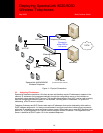
Deploying SpectraLink 8020/8030
Wireless Telephones
May 2009 Best Practices Guide
1 Introduction
Wi-Fi telephony, also known as Voice over Wireless LAN (VoWLAN), delivers the capabilities and
functionality of the enterprise telephone system in a mobile handset. The Wi-Fi handset is a WLAN client
device, sharing the same wireless network as laptops and PDAs. For enterprise use, the handset is
functionally equivalent to a wired desk phone, giving end-users all the features they are used to having in
wired office phone. The benefits of VoWLAN can result in substantial cost savings over other wireless
technologies by leveraging the Wi-Fi infrastructure and by eliminating recurring charges associated with
the use of public cellular networks. For end users, VoWLAN can significantly improve employee mobility,
resulting in increased responsiveness and productivity.
Delivering enterprise-grade VoWLAN means that wireless networks must be designed to provide the
highest audio quality throughout the facility. Because voice and data applications have different attributes
and performance requirements, thoughtful WLAN deployment planning is a must. A Wi-Fi handset
requires a continuous, reliable connection as a user moves throughout the coverage area. In addition,
voice applications have a low tolerance for network errors and delays. Whereas data applications are
able to accept frequent packet delays and retransmissions, voice quality will deteriorate with just a few
hundred milliseconds of delay or a very small percentage of lost packets. Whereas data applications are
typically bursty in terms of bandwidth utilization, voice conversations use a consistent and a relatively
small amount of network bandwidth.
Using a Wi-Fi network for voice is not complex, but there are some aspects that must be considered. A
critical objective in deploying enterprise-grade Wi-Fi telephony is to maintain similar voice quality,
reliability and functionality as is expected from a wired telephone. Some key issues in deploying Wi-Fi
telephony include WLAN coverage, capacity, quality of service (QoS) and security.
Polycom pioneered the use of VoWLAN in a wide variety of applications and environments, making the
SpectraLink Wireless Telephone the market leader in this category. Based on our experience with
enterprise-grade deployments, this guide provides recommendations for ensuring that a network
environment is optimized for use with SpectraLink e340/h340/i640 Wireless Telephones.
1.1 SpectraLink e340/h340/i640 Wireless Telephones
The information contained in this guide applies only to SpectraLink e340/h340/i640 Wireless Telephones
(generically referred to as ‘handsets’ throughout this document) and their OEM derivatives. Detailed
product information for the SpectraLink e340/h340/i640
can be found at Polycom’s web site. For
information on other Polycom Wi-Fi handsets, including the SpectraLink 8020/8030 or 8002 Wireless
Telephones, visit the appropriate product page at www.polycom.com.
1.2 SpectraLink Infrastructure
Throughout this guide references are made to SpectraLink infrastructure equipment including the SVP
Server, Telephony Gateway and OAI Gateway. These LAN-based devices are sold by Polycom for use
with the SpectraLink e340/h340/i640 Wireless Telephone:
An SVP Server is required, as it provides the necessary WLAN QoS for the handset.
Telephony Gateways allow the handset to operate as an extension off of a PBX. For systems
with four or fewer Telephony Gateways, the integrated SVP Server capability can be used and a
separate SVP Server is not required. For systems with more than four Telephony Gateways, a
separate SVP Server is required.
The OAI Gateway enables third-party applications to send and respond to real-time text
messages and alerts using SpectraLink handsets.
3
©2009 Polycom, Inc. All rights reserved.
Polycom and the Polycom logo are registered trademarks of Polycom, Inc. All other trademarks are the property of Polycom, Inc. or their respective companies.


















